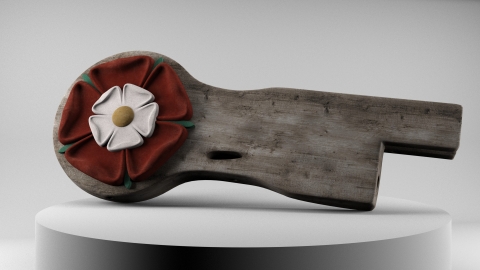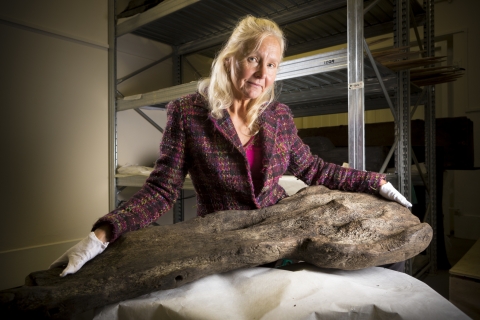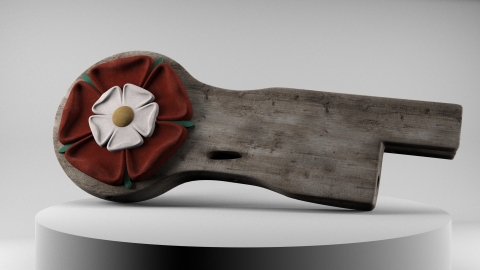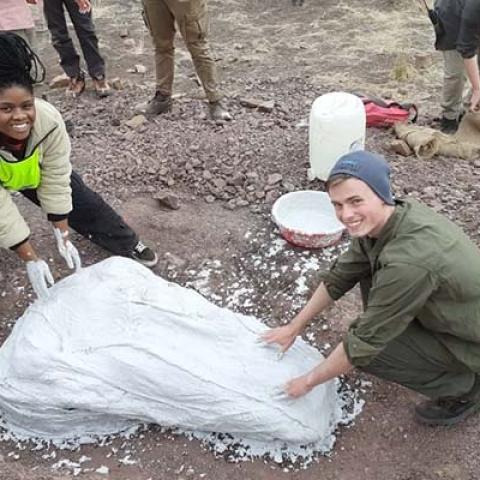

The figurehead of the Mary Rose has gone on public display for the first time – and experts from the University of Portsmouth have helped to show how it would have looked in its original state.
The carved wooden emblem representing a Tudor rose once adorned the bow of Henry VIII’s favourite warship and was recovered from the Solent seabed during excavations between 2003 and 2005.
A University team led by Dr Vaughan Powell worked with members of the Mary Rose Trust to create a visualisation of the figurehead, which visitors will be able to see when the Mary Rose Museum, at Portsmouth Historic Dockyard, reopens today following a £39m investment.
The artefact, which would have been brightly coloured in its original state, has been significantly eroded during its time under water, but elements of the carving remain. It is believed to be the first English warship figurehead carved to represent the name of the ship.
Over the last few months a team of researchers from the School of the Environment, Geography and Geosciences and the School of Creative Technologies has worked with the Mary Rose Trust to piece together a 3D visualisation of the emblem.
Martin Schaefer and Linley Hastewell, of the geography team, used laser scanning devices to capture the shape of the artefact.

Alex Hildred, Head of Research and Curator of Ordnance for the Mary Rose Trust, pictured with newly recovered Mary Rose emblem.
Picture: Chris Ison

Digital rendering of the Mary Rose emblem created at the University of Portsmouth.
Meanwhile, senior geography lecturer Dr Dominic Fontana undertook shadow photography of the figurehead – using an oblique light source to create exaggerated shadows of the surface relief of the object – which allowed the visualisation team to interpret the heavily eroded surface of the original.
Dr Fontana said: “I’ve been working on the Mary Rose project for more than 35 years, but until now I have never worked on an object which symbolised the whole ship and its crew as one.
“The emotional connection that the ship’s Tudor rose symbol makes with us is a very strong one. Yesterday was the 471st anniversary of the sinking of the Mary Rose – that’s 471 years since the ship’s Tudor rose sank beneath the waves with the loss of about 500 lives.”
The coordinate data and shadow photographs were then used by Dr Powell and Dr Peter Howell of Creative Technologies to construct a virtual model of the object.
Dr Powell, a senior lecturer, said: “All members of the team have been directly involved throughout the process, from scanning and capture through analysis and interpretation to modelling and visualisation. I would like to express thanks to all the team for making this possible in a remarkably short period of time.”
In addition, a team from the Faculty of Creative and Cultural Industries, led by principal lecturer Charlie Watts, made a video about the figurehead and the creation of the virtual model.
The emotional connection that the ship’s Tudor rose symbol makes with us is a very strong one. Yesterday was the 471st anniversary of the sinking of the Mary Rose – that’s 471 years since the ship’s Tudor rose sank beneath the waves with the loss of about 500 lives.
Staff and students from the BA (Hons) Film Production and BSc (Hons) TV and Broadcasting courses also got involved by helping to create videos that are being projected onto the Mary Rose as part of the revamped exhibition.
Mr Watts said: “This has been a successful partnership that hopefully will lead to more collaborative projects with the Mary Rose Trust. I’m grateful to the trust staff and to Dr Powell for making this such a great experience.”
The new-look Mary Rose Museum offers stunning panoramic views of the ship from all nine galleries through floor-to-ceiling glazing on the lower and main decks.
The only 16th century warship on display in the world, the Mary Rose has undergone continuous conservation since she was raised from the Solent in 1982.
The warship sank in the Solent on 19 July 1545, while leading an attack on the galleys of a French invasion fleet.


